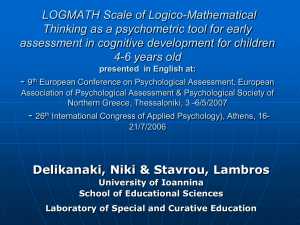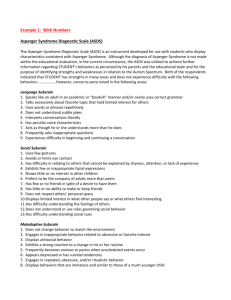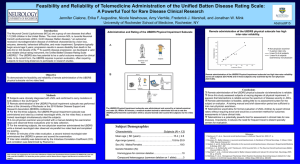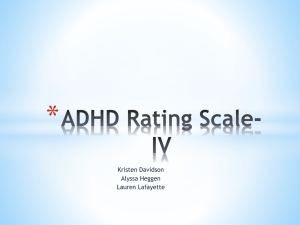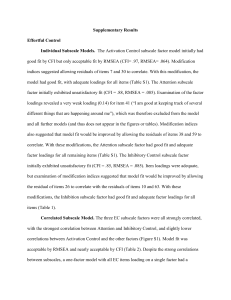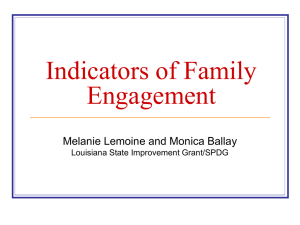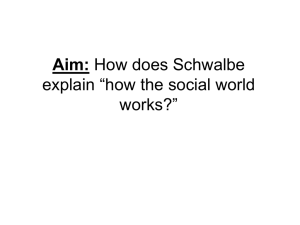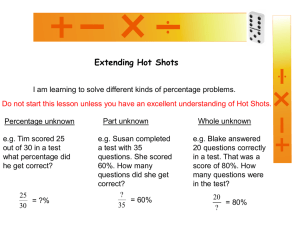How to calculate scores
advertisement
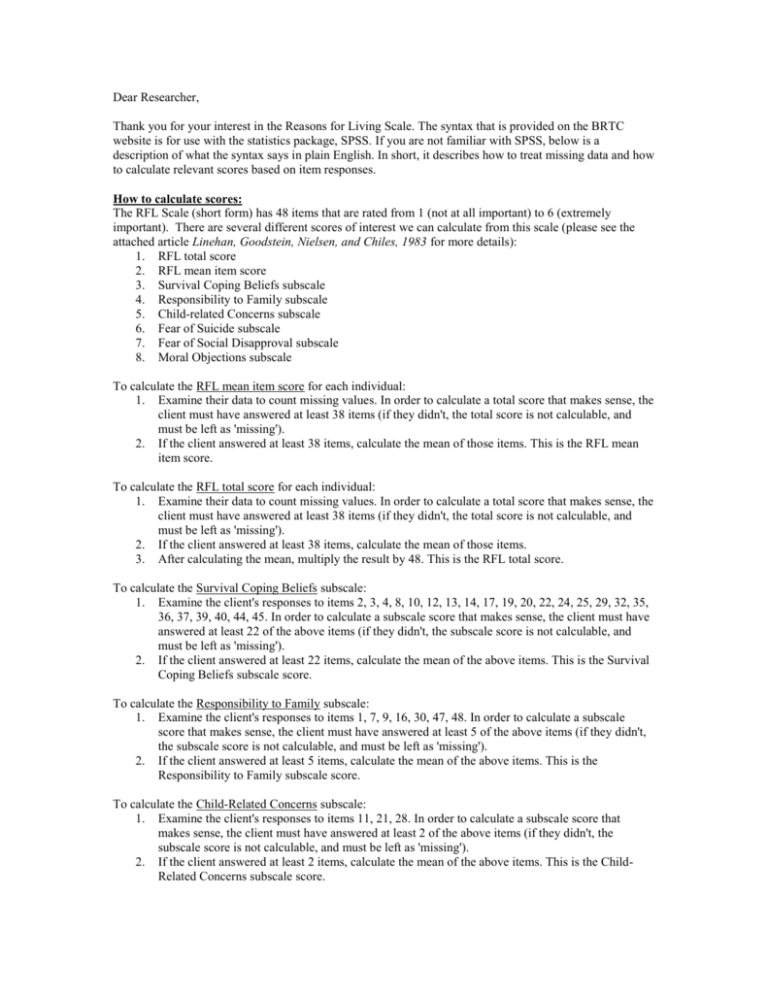
Dear Researcher, Thank you for your interest in the Reasons for Living Scale. The syntax that is provided on the BRTC website is for use with the statistics package, SPSS. If you are not familiar with SPSS, below is a description of what the syntax says in plain English. In short, it describes how to treat missing data and how to calculate relevant scores based on item responses. How to calculate scores: The RFL Scale (short form) has 48 items that are rated from 1 (not at all important) to 6 (extremely important). There are several different scores of interest we can calculate from this scale (please see the attached article Linehan, Goodstein, Nielsen, and Chiles, 1983 for more details): 1. RFL total score 2. RFL mean item score 3. Survival Coping Beliefs subscale 4. Responsibility to Family subscale 5. Child-related Concerns subscale 6. Fear of Suicide subscale 7. Fear of Social Disapproval subscale 8. Moral Objections subscale To calculate the RFL mean item score for each individual: 1. Examine their data to count missing values. In order to calculate a total score that makes sense, the client must have answered at least 38 items (if they didn't, the total score is not calculable, and must be left as 'missing'). 2. If the client answered at least 38 items, calculate the mean of those items. This is the RFL mean item score. To calculate the RFL total score for each individual: 1. Examine their data to count missing values. In order to calculate a total score that makes sense, the client must have answered at least 38 items (if they didn't, the total score is not calculable, and must be left as 'missing'). 2. If the client answered at least 38 items, calculate the mean of those items. 3. After calculating the mean, multiply the result by 48. This is the RFL total score. To calculate the Survival Coping Beliefs subscale: 1. Examine the client's responses to items 2, 3, 4, 8, 10, 12, 13, 14, 17, 19, 20, 22, 24, 25, 29, 32, 35, 36, 37, 39, 40, 44, 45. In order to calculate a subscale score that makes sense, the client must have answered at least 22 of the above items (if they didn't, the subscale score is not calculable, and must be left as 'missing'). 2. If the client answered at least 22 items, calculate the mean of the above items. This is the Survival Coping Beliefs subscale score. To calculate the Responsibility to Family subscale: 1. Examine the client's responses to items 1, 7, 9, 16, 30, 47, 48. In order to calculate a subscale score that makes sense, the client must have answered at least 5 of the above items (if they didn't, the subscale score is not calculable, and must be left as 'missing'). 2. If the client answered at least 5 items, calculate the mean of the above items. This is the Responsibility to Family subscale score. To calculate the Child-Related Concerns subscale: 1. Examine the client's responses to items 11, 21, 28. In order to calculate a subscale score that makes sense, the client must have answered at least 2 of the above items (if they didn't, the subscale score is not calculable, and must be left as 'missing'). 2. If the client answered at least 2 items, calculate the mean of the above items. This is the ChildRelated Concerns subscale score. To calculate the Fear of Suicide subscale: 1. Examine the client's responses to items 6, 15, 18, 26, 33, 38, 46. In order to calculate a subscale score that makes sense, the client must have answered at least 5 of the above items (if they didn't, the subscale score is not calculable, and must be left as 'missing'). 2. If the client answered at least 5 items, calculate the mean of the above items. This is the Fear of Suicide subscale score. To calculate the Fear of Social Disapproval subscale: 1. Examine the client's responses to items 31, 41, 43. In order to calculate a subscale score that makes sense, the client must have answered at least 2 of the above items (if they didn't, the subscale score is not calculable, and must be left as 'missing'). 2. If the client answered at least 2 items, calculate the mean of the above items. This is the Fear of Social Disapproval subscale score. To calculate the Moral Objections subscale: 1. Examine the client's responses to items 5, 23, 27, 34. In order to calculate a subscale score that makes sense, the client must have answered at least 2 of the above items (if they didn't, the subscale score is not calculable, and must be left as 'missing'). 2. If the client answered at least 2 items, calculate the mean of the above items. This is the Moral Objections subscale score. What do these scores mean: Linehan et al., 1983 describes the use of the Reasons for Living Scale in two groups: a sample of n=197 Seattle shoppers representative of the general population, and a clinical group of n=175 individuals admitted to inpatient psychiatric units in Seattle for an immediately prior parasuicide, suicide ideation, or other serious, nonsuicide-related problems. In Tables 2 and 4 (pages 280 and 282, respectively), there are mean values published for seven different subgroups that you can use to compare your results to: 1. General Population a. Never suicidal (NVS) b. History of brief suicidal ideation (HBSI) c. History of serious suicidal ideation (HSSI) d. History of parasuicide (HP) 2. Clinical Population a. Current parasuicide b. Current suicide ideator c. Currently nonsuicidal SPSS scoring syntax: ****RFL SCORING SYNTAX****. MISSING VALUES rfl01 to rfl72 (Lo thru -1). COMPUTE rfctot = 48*(MEAN.38(rfl01,rfl02,rfl03,rfl04,rfl05,rfl06,rfl07,rfl08,rfl09,rfl10 ,rfl11,rfl12,rfl13,rfl14,rfl15,rfl16,rfl17,rfl18,rfl19,rfl20,rfl21,rfl2 2,rfl23,rfl24,rfl25,rfl26,rfl27,rfl28,rfl29,rfl30,rfl31,rfl32,rfl33,rfl 34,rfl35,rfl36,rfl37,rfl38,rfl39,rfl40,rfl41,rfl41,rfl42,rfl43,rfl44,rf l45,rfl46,rfl47,rfl48)). COMPUTE rfctotmn = MEAN.38(rfl01,rfl02,rfl03,rfl04,rfl05,rfl06,rfl07,rfl08,rfl09,rfl10,rfl 11,rfl12,rfl13,rfl14,rfl15,rfl16,rfl17,rfl18,rfl19,rfl20,rfl21,rfl22,rf l23,rfl24,rfl25,rfl26,rfl27,rfl28,rfl29,rfl30,rfl31,rfl32,rfl33,rfl34,r fl35,rfl36,rfl37,rfl38,rfl39,rfl40,rfl41,rfl41,rfl42,rfl43,rfl44,rfl45, rfl46,rfl47,rfl48). COMPUTE rfcscb = MEAN.22(rfl02,rfl03,rfl04,rfl08,rfl10,rfl12,rfl13,rfl14,rfl17,rfl19,rfl 20,rfl22,rfl24,rfl25,rfl29,rfl32,rfl35,rfl36,rfl37,rfl39,rfl40,rfl42,rf l44,rfl45). COMPUTE rfcrf =MEAN.5(rfl01,rfl07,rfl09,rfl16,rfl30,rfl47,rfl48). COMPUTE rfccrc =MEAN.2(rfl11,rfl21,rfl28). COMPUTE rfcfs =MEAN.5(rfl06,rfl15,rfl18,rfl26,rfl33,rfl38,rfl46). COMPUTE rfcfsd = MEAN.2(rfl31,rfl41,rfl43). COMPUTE rfcmo = MEAN.2(rfl05,rfl23,rfl27,rfl34). EXECUTE. VARIABLE LABELS rfctot 'RFL sum total score' rfctotmn 'RFL mean item score' rfcscb 'Survival Coping Beliefs' rfcrf 'Responsibility to Family' rfccrc 'Child-related Concerns' rfcfs 'Fear of Suicide' rfcfsd 'Fear of Social Disapproval' rfcmo 'Moral Objections'. If you have any other questions about this instrument or others, please contact Safia Jackson at jackson@brtc.psych.washington.edu.

